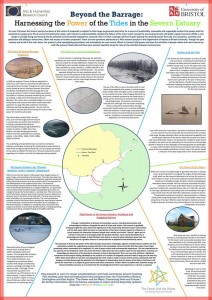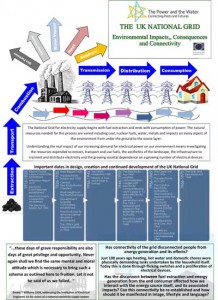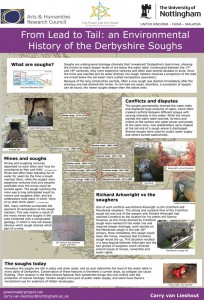Professor Peter Coates, School of Humanities, University of Bristol
PI of The Power and the Water, funded under AHRC Care for the Future: Thinking Forward through the Past
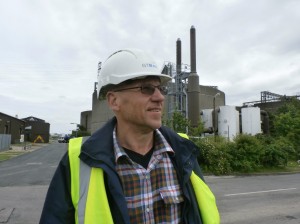
Peter at project partner Northumbrian Water’s Howdon Sewage Plant, Newcastle, on an unseasonably chilly day – even for the northeast – in June (photo: Jill Payne)
One of the places ‘The Power and the Water’ team visited during our gathering on Tyneside in June 2014 was the Baltic Centre for Contemporary Art, on the river’s Gateshead (south) bank. The exhibit that caught my attention was ‘Near Here’ by Nina Canell, who, a guidebook explains, is ‘fascinated by forces that affect us every day but that we can’t see with our eyes – things like electricity and air. If we can’t see them, how do we know they exist?’ Canell takes materials like cables, steel and water to create sculpture that, according to the Baltic’s press release, gives ‘substance to the intangible’. This strategy renders the invisible visible and brings the seemingly distant closer to us (near here?). The installation ‘Forgetfulness (Dense)’ consisted of a water-filled tank (raised on a frame like a display case) that contained a suspended length of underwater telecommunications cable which bore an uncanny resemblance to an oversized, particularly colourful liquorice all-sort. The combination of power and water appealed to me, as did the severed nature of the cable: a power supply cut off at both ends, disconnected from its source and destination.
Environmental connectivities reside at our project’s heart and supply the ties that bind its three strands. Strand 1 (based with me in Bristol) addresses river systems and their connected bio-physical, energetic, commercial and cultural flows (with reference to Tyne and Severn). [See below Alexander Portch’s poster on the broader historical context for barrage proposals to generate electricity from the Severn Estuary’s tidal power (Severn Estuary Partnership, Severn Estuary Forum 2014, Cardiff, September 2014). Alexander is the research student at Bristol.]
Strand 2 (based with Paul Warde at the University of East Anglia, though about to move with him to Cambridge at the end of this year) deals with infrastructure and energy systems/sectors and their connected sites of generation, transmission and consumption (with reference to the national grid’s emergence and the energy environments of twentieth-century Somerset). [See below Kayt Button’s poster on the UK National Grid (Second World Congress of Environmental History, Portugal, July 2014). Kayt is the research student at UEA.]
Strand 3 (based with Georgina Endfield at Nottingham) examines the infrastructure of constructed watercourses and how they connect notions of natural and cultural heritage and watercourses above and below ground (with reference to soughs [drainage channels/artificial rivers] in Derbyshire’s former lead mining district). [See below Carry van Lieshout’s poster on soughs in Derbyshire’s former lead mining areas (Second World Congress of Environmental History, Portugal, July 2014). Carry is the post-doctoral researcher at Nottingham.]
Our project logo (Jonny Aldrich’s winning entry in an open design competition for students of Graphic Communication at Plymouth University) foregrounds connectivity. The first of the three triangles (green) joins up the locations of our three universities to convey Connection and Landscape. Jonny then duplicated and rotated the triangle twice to form an abstract star that represents Energy/ Power/ Electricity (Gold), Environment/ Landscape (Green) and Water (Blue).
We are constantly on the lookout for connective tissue, which usually resides beneath the surface, like the infrastructure of sewage and water pipes, broadband Internet cables and other electrical wiring within the walls and under the floorboards of where we live and work. Where this domestic analogy breaks down, though, is that in the lives of the people, and the enveloping places and socio-natural systems we study, not all of the connections between point of supply and point of use, between places of production and places of consumption, remain ‘live’.
‘Power and Water’ is in the business of re-establishing severed connections. Reading up on Canell after I visited her exhibit, I was relieved to find that I hadn’t been too reductive in embracing her artworks as richly suggestive material for our project. Through objects such as ‘amputated’ cables, one reviewer explained, she ‘puts industrial, mundane objects that connect the sources of energy of our modern world into the viewer’s consciousness’ (Morais, 2014). And in a video interview, Canell explained that ‘Near Here’ aims to ask questions such as ‘what is nearness?’ and to examine notions of proximity and distance. The electric cable helps her grapple with ideas of movement and fluidity – and the interruption of a connective form when it is chopped up.
As our project moves into the second of our three years, we are devoting increasing thought to how the three strands connect. While they are all self-standing and discrete, with their own distinctive themes and flavours, we want to tease out the connections and foreground them in publications that emerge. Potentially nourishing food for connective thought is provided by the twin notions of the ground and the grid that Paul Warde brought to our attention at the Newcastle meeting and has expanded on in a recent blog. Referring to the changes in the agrarian landscape of his boyhood home, Seamus Heaney noted ‘that old sense of tillage and season and foliage has disappeared. Once trees and hedges and ditches and thatch get stripped, you’re in a very different world. You’re deserting the ground for the grid’ (O’Driscoll, 2008: 24). The duality of ground and grid also encompasses the polarities of traditional and modern, personal and impersonal, real and abstract, connection and disconnection as well as of place and placeless. Largely absent from the grid are the qualities of materiality and tangibility: we cannot see it, touch it, or manipulate it. And, unless we visit a nuclear power station or hydro plant, we find it hard to place. Moreover, in forging new connections, the grid creates disconnections, empowering and disempowering.
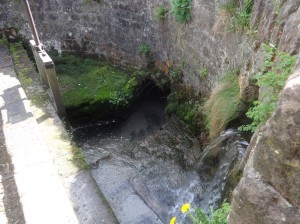
Cromford Sough Tail, near Cromford Mills, Derbyshire, site of the first water-powered cotton spinning mill developed by Richard Arkwright in 1771, and locale of a recent team meeting (photo: Georgina Endfield)
‘The Power and the Water’ explores why we so readily recognize dualities such as ground and grid but also their complicated nature. Our trip to Tyneside, for instance, deepened our appreciation of the complex connections between Tynesiders and the Tyne. We might assume that the river’s industrialization, the canalization of its form, the depletion of its biotic life and the degradation of its water loosened more intimate pre-industrial bonds, so that people turned their backs on the river. And we might also assume that, with deindustrialization and ecological revival since the 1970s, Tynesiders are returning to the urban river, rediscovering lost connections. Yet the association of a dirty river with a dead, disconnected river is by no means axiomatic. For those who worked on the river during the heyday of commerce and industrialism, a working river was a living river, a big river they felt connected to. A river might be dirty, but, more vitally, it was busy, and a busy river was very much alive – a river to which people felt closely connected and in which they were grounded. In 1995, the Newcastle singer and actor, Jimmy Nail, released the elegiac song ‘Big River’. ‘When coal was king’ and the tidal river bristled with the shipyards of Swan Hunter, the Tyne was ‘a living thing’ , a mighty, mightily impressive watercourse that was a huge source of pride regardless of its state of naturalness or cleanliness. In his bittersweet tribute to the Big River that has become a Small River in a post-industrial age, a dead river was a deindustrialized river, not a biologically deceased river. Those who share Nail’s sentiments now feel more distanced from a river whose significance has shrunk enormously since the shipyards shut (also the subject of Sting’s most recent album, ‘The Last Ship’) and the mines closed, pulling the plug on their local connection as the river is transformed from the ground into the grid.
Through a series of site-based studies, the project emphasizes the place- and context-specific character of ‘environmental connectivity’; its historical development and contingency; and the idioms that have been employed to explain and convey understanding of environmental change, as well as the language we use to talk about different types of infrastructure. What kind of future envisioning, and possibilities for progress toward sustainable development or risks of degradation and dissolution, are associated with particular forms of environmental connectivity? How far are people and communities aware of connections undergirding their lives? And do we frame examples of environmental change and infrastructure in a common tongue or disparate language?
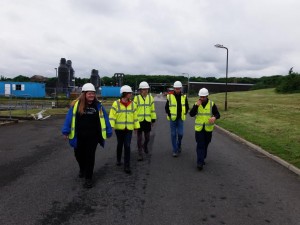
Project team members (left to right) Leona Skelton, Erin Gill (impact and engagement officer), Carry van Lieshout and Alexander Portch, with Northumbrian Water official, at Howdon Sewage Treatment Works, Newcastle, 5 June 2014 (photo: Marianna Dudley)
To date, the full team has gathered for meetings in London (November 2013), Newcastle (June 2014) and the Peak District (October 2014). There was also full representation at the Second World Congress of Environmental History (Guimaraes, Portugal, July 2014), where we organized a panel on ‘Fluvial histories of the Tyne and Severn: connective flows in and between two major British rivers’, another team member presented a paper on ‘Nuclear pasts and fracking futures in southwest England’, and others displayed posters (another venue for poster display was the Severn Estuary Partnership’s 2014 Forum).
Team members also generate a steady stream of substantial blogs – well over thirty to date – about their activities. These have included visits to a state-of-the-art sewage treatment plant in Newcastle; a Five Star Severn Bore; a Barmote (ancient court dealing with disputes and claims related to lead mining since 1288) in Derbyshire; the South Western Electricity History Society’s Museum of Electricity in suburban Bristol; and Hinkley Point Nuclear Power Station (you can subscribe to receive e-mail notification of new blog posts). There is also a regular flow of other postings, among them project student Kayt Button’s call for recollections of how individuals, families and communities perceived and received the arrival of electricity.
As well as working with a range of external groups (including the Clean Tyne Project, Tyne Rivers Trust, Peak District National Park Authority and Peak District Mines Historical Society – Carry and Georgina recently gave a talk at the latter group’s AGM), we’re also hooking up with adjacent AHRC projects. Angela Connelly, a researcher on the Jetty Project (an artwork-based project focused on Dunston Staiths, a wooden structure [1893] on the Tyne for loading coal onto ships that is reputedly Europe’s largest wooden structure), led our project team on a field trip – a joint activity that generated a cross-posted report (http://jetty-project.info/connecting-with-power-and-the-water/).
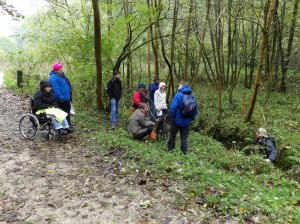
Team members with archaeologist John Barnatt of Peak District National Park Authority (in the ditch, to the right), Lathkill Dale, 8 October 2014 (photo: Jill Payne)
Four members of another project funded through Care for the Future’s ‘Environmental Change and Sustainability’ highlight call, ‘Material Cultures of Energy: Transitions, Disruption, and Everyday Life in the Twentieth Century’ (PI: Frank Trentmann) attended our Peak District meeting at Cromford Mills to discuss potential synergies – and Paul is a member of its advisory board. Meanwhile, Georgina’s sough strand is in discussion with colleagues on the Connected Communities programme project, ‘Stories of Change: The Past, Present and Future of Energy’ (PI: Joe Smith), one of whose three stories (‘Industry Story: Future Works’) shares a Derbyshire dimension (and Paul is a ‘story fellow’ on this project). We are also in contact with another Connected Communities project, ‘Towards Hydrocitizenship: Connecting communities with and through responses to interdependent, multiple water issues’ (PI: Owain Jones), which includes a Bristol case study, not least with regard to plans for coordinating and linking our projects’ contributions to next June’s Festival of Nature, an annual Bristol-based event which, in 2015, will be given added weight by Bristol’s status as European Green Capital.
Further details about the project can be found at: http://powerwaterproject.net/
Follow Power & Water (@envirohistories) on Twitter

